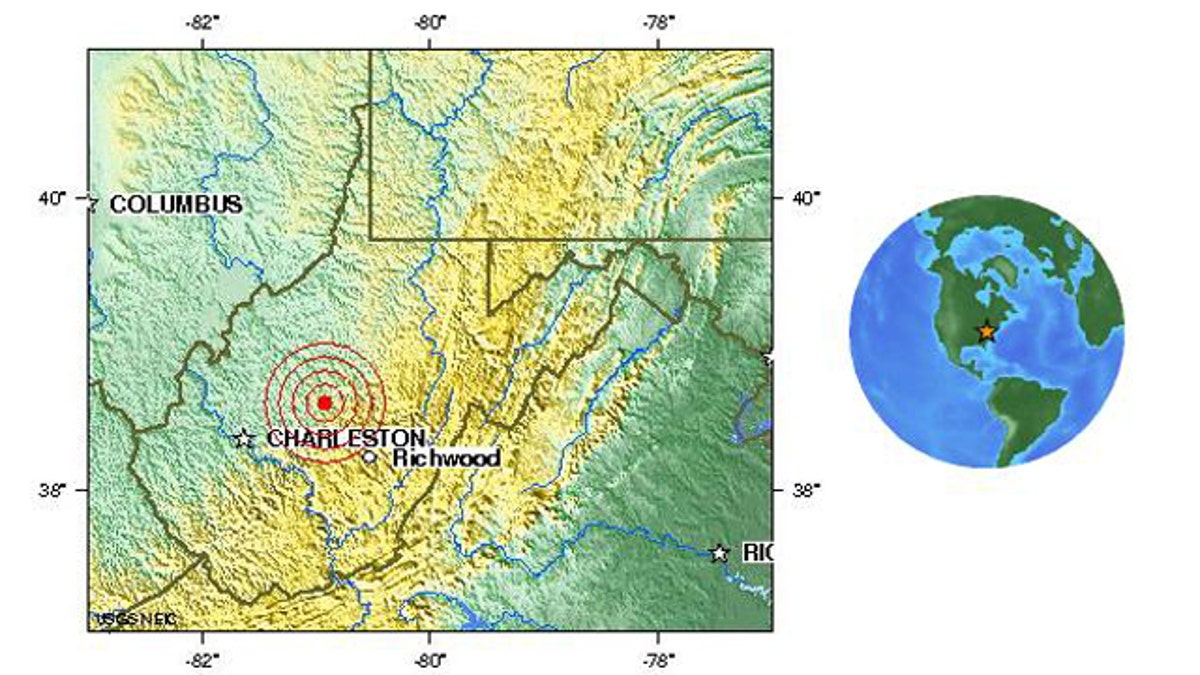
A map on the USGS Web site shows the location of a magnitude 3.4 earthquake that struck West Virgina April 4, mere days before a deadly methane gas explosion in a nearby mine. (USGS National Earthquake Information Center)
Two seismic events -- one natural, the other manmade -- occurred not far from a West Virginia coal mine just days before a suspected methane explosion left 25 miners dead and four missing.
An earthquake registering magnitude 3.4 occurred early Sunday morning about 100 miles northeast of Montcoal, W. Va., the location of the Upper Big Branch Mine, a massive coal mining operation where an explosion killed and trapped miners more than a mile below the surface on Monday.
An earthquake of that magnitude is strong enough to dislodge pockets of methane gas, though the distance from the mine suggests that it would not have affected the explosion, Julie Dutton, a geophysicist with the U.S. Geological Survey, told FoxNews.com.
"There's the definite possibility that that's what could have happened, but not from this earthquake," Dutton said. "This one was too far away and days separated. That makes a big difference."
Methane is one of the great dangers of coal mining, and federal records say the Eagle coal seam releases up to 2 million cubic feet of the gas into the Upper Big Branch mine every 24 hours, which is a large amount, said Dennis O'Dell, health and safety director for the United Mine Workers labor union.
In mines, giant fans are used to keep concentrations of the colorless, odorless gas below certain levels. If the gas is allowed to build up, it can explode with a spark or static charge.
Another seismic event, this one man-made, took place closer to the mine on Saturday, April 3, when surface blasting at a nearby mine was initially mistaken for a minor quake of 2.9 magnitude. Dutton explained that with details still emerging, it was impossible to rule out the effects of this nearby seismic activity conclusively, though again she suspects that there was no connection.
"The cause could have been an earthquake, but probably not," she told FoxNews.com. Without specific details about the mine blast that have yet to be be conclusively determined, it's impossible to say for sure.
If we had a really specific time, we might be better able to rule out a quake," she said.
Diane Noserale, an information specialist for the USGS, echoed Dutton. She explained that the earth-science agency had looked for earthquakes as a direct cause of the explosion, examining the seismic waves that came from the mine blast.
"None of the seismic waves had any signatures that would have indicated an earthquake," she said. "A trained seismologist can tell the difference."
Professor Martin Chapman at Virginia Tech, an expert on mine-related seismic activity, said he believes seismic waves will probably not turn out to have been the caus. He pointed out that "we are not likely to see any seismic signal from the methane explosion that killed the miners -- such events rarely couple well enough with the surrounding rock to create much seismic energy." Apparently, methane explosions simply don't cause large seismic waves.
Paul Earle, a geophysicist with the USGS National Earthquake Information Center in Golden, Colo., agreed that the nearby earthquake almost certainly was unrelated. "Susan Potter at NEIC and Martin Chapman looked for any signal that might have come from the accident and they did not see anything," he said, stating conclusively that "there is NO relation between the event on the Web and the mining accident.
"It is unlikely (but not impossible) that any signal will be found," he added, "because methane explosions do not generate large seismic waves."
